Comprehensive Energy Data Intelligence
Information About Energy Companies, Their Assets, Market Deals, Industry Documents and More...
These 8 US States Now Get Most of Their Renewables: Solar, Wind and More
08/13/2024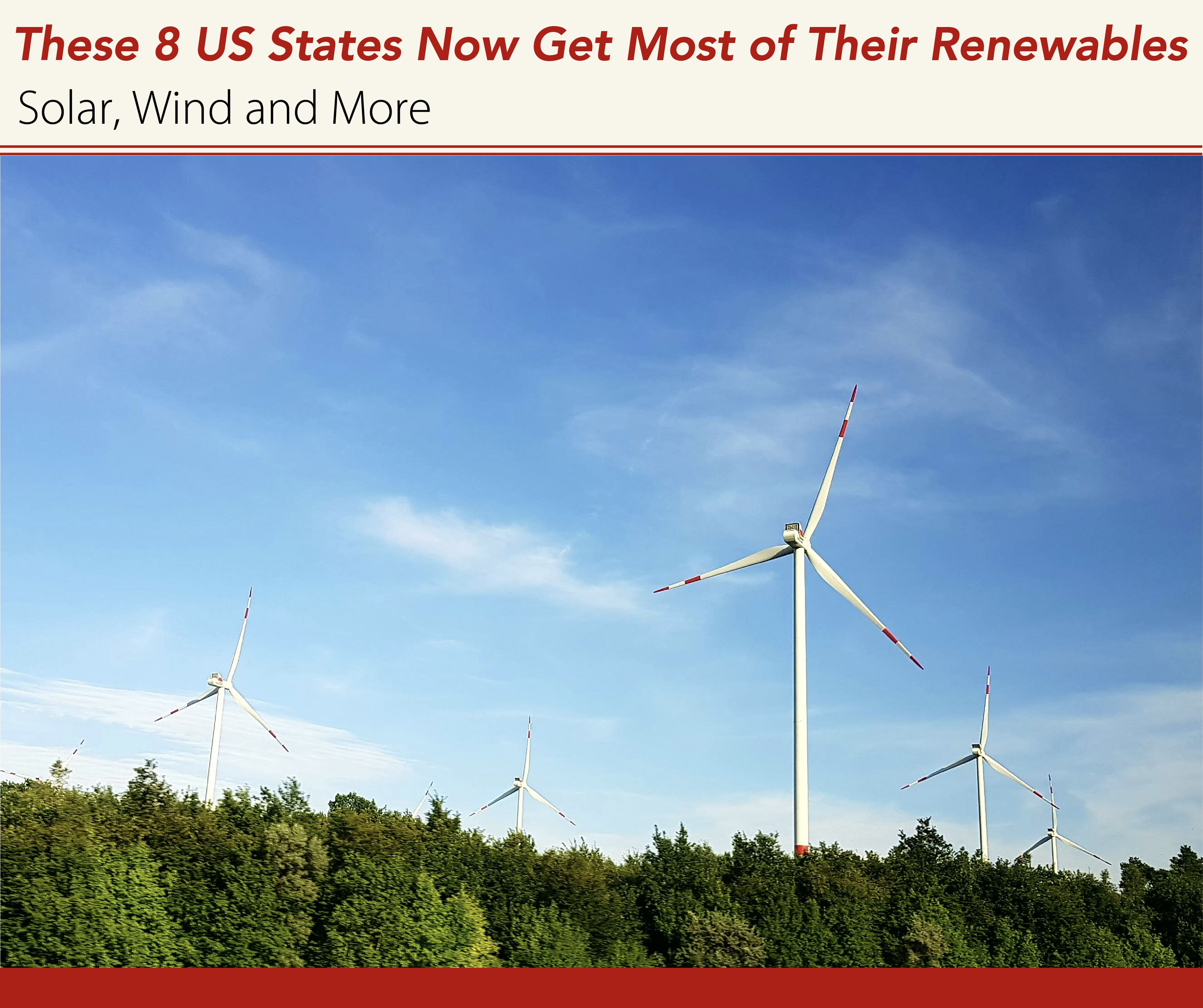
Last year, a Pew Research Center survey revealed that 67% of Americans are in favor of developing alternative energy sources. Similarly, an Eligo Energy survey indicated that 65% of U.S. consumers are prepared to pay a premium for renewable energy.
According to Mordor Intelligence, the U.S. renewable energy market is projected to reach 434.5 GW in 2024, with further growth expected at an annual rate of 10.01%, reaching 700.15 GW by 2029.
The U.S. Energy Information Administration (EIA) also forecasts a positive future for renewable energy. Their recent report suggests that the decline in electricity generation from natural gas and coal will fuel the growth of renewables in 2025, with expected decreases of 1% and 3% in natural gas and coal generation, respectively. Solar energy is expected to lead this growth, with the electric power sector expanding its solar capacity by 19 GW in 2023, and an additional 36 GW in 2024 and 35 GW in 2025. As a result, solar power is anticipated to make up 6% of the total electricity generation in the U.S. by 2025.
TOP US States That Produce the Most Renewable Energy
New York
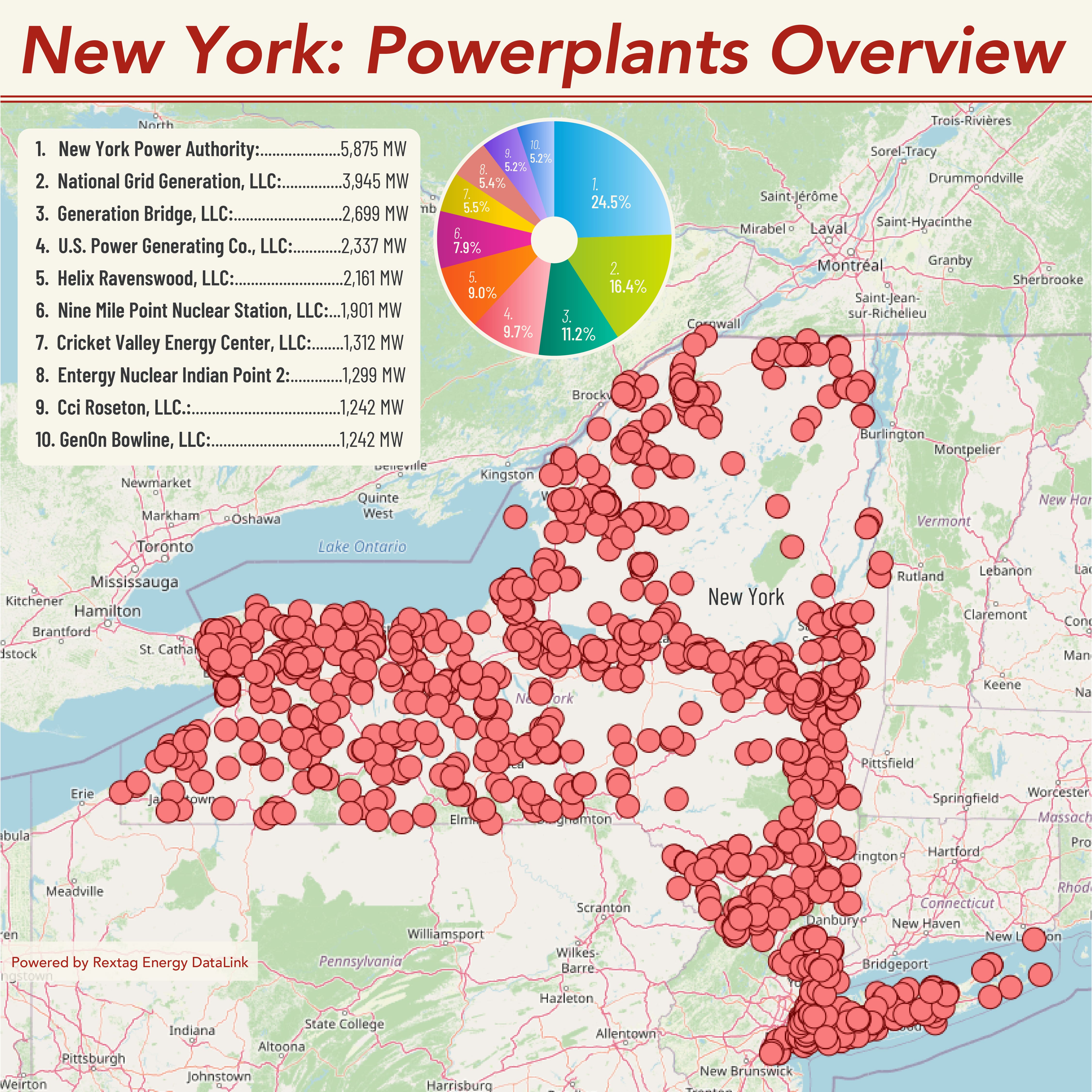
- Power Plants: 124955 MW
- Solar: 63726 MW
- Wind: 2204 MW
- Biodisel Plants: 1.5 Mmgal/yr capacity
Over half of New Customer’s electricity already comes from clean sources
New York is a great example of the nation's aggressive push toward renewable energy. By 2030, the state aims to get 70% of its electricity from renewables and achieve 100% carbon-free power by 2040, incorporating both renewable and nuclear energy. Impressively, in 2022, these sources together generated 51% of the state's electricity.
Nuclear plants in New York are treated as zero-emission sources. For facilities that can’t fully eliminate emissions, the state allows the purchase of carbon offsets. These must be locally sourced from initiatives like forest management or sustainable agriculture. Notably, New York boasts the country's lowest per capita carbon emissions.
In terms of specific renewables, hydroelectric power is the heavyweight, contributing significantly to the state's energy mix. Solar energy also plays a growing role, accounting for 4% of total power in 2022. Remarkably, two-thirds of this solar output came from small setups like rooftop panels, backed by incentives like net metering. New York is ranked third nationally for its small-scale solar energy production.
Wind energy, once the state's leading renewable source, now follows solar, making up about 12% of New York's renewable output in 2022. The state has installed over 2,500 megawatts across 32 wind farms and is eyeing further expansion, particularly offshore along the Great Lakes and Long Island, aiming to add at least 9,000 megawatts by 2035 despite some economic hurdles.
Texas

- Power Plants: 403649 MW
- Solar: 10599 MW
- Wind: 40206 MW
- Hydrogen Plants: 2699 MMcf/d
- Carbon Capture Storage: Max Capacity 133.65 million tonnes per annum (MTPA)
Texas is a leader in wind power, producing over a quarter of the U.S. total
In 2022, renewable resources were responsible for about one-fourth of Texas's in-state electricity generation. The state played a significant role nationally, accounting for 15% of the U.S. total electricity generation from renewables and 29% from non-hydroelectric renewable sources. Texas's prowess in utility-scale wind-powered electricity was particularly notable, as it generated more than a quarter of the nation’s total wind energy.
By early 2023, Texas had amassed over 12,400 megawatts of utility-scale renewable capacity from sources other than wind. Including small-scale solar projects, this figure rose to nearly 14,600 megawatts.
As of February 2023, Texas boasted nearly 40,000 megawatts of wind capacity. This impressive number constituted more than a quarter of the state's total utility-scale generating capacity and almost three-fourths of its renewable capacity, which includes small-scale solar installations.
Texas also ranks high in solar power potential, placing sixth nationwide. In 2022, it was the second-largest producer of solar power in the country, trailing only California. By early 2023, the combined solar PV capacity from both large- and small-scale facilities in Texas exceeded 13,500 megawatts. Solar energy contributed about 5% to the state's total electricity generation for the year, with small-scale solar facilities providing about one-eighth of the solar total.
California
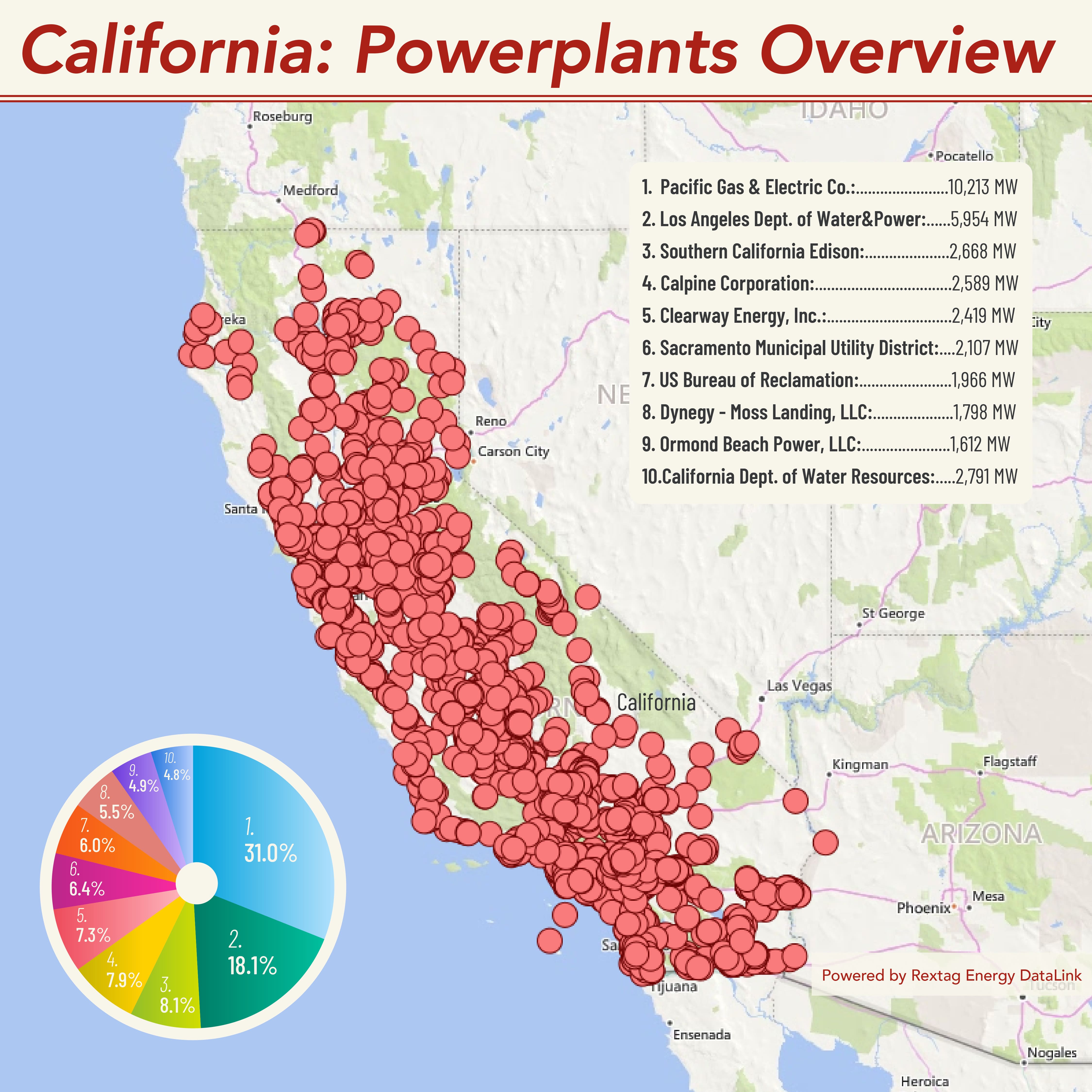
- Power Plants: 307762 MW
- Solar: 140330 MW
- Wind: 8947 MW
- Hydrogen Plants: 2240 MMcf/d
- Geothermal: 2603 Geothermal Sites
- Carbon Capture Storage: Max Capacity 1.72 million tonnes per annum (MTPA)
California leads the nation in both solar power and geothermal energy production
California ranks second only to Texas in overall electricity generation from renewable sources. It stands out as the top U.S. producer of solar and geothermal energy. In 2022, the state was also ranked as the second-largest producer of electricity from biomass, behind Georgia, and was fourth in conventional hydroelectric power production, trailing Washington, Oregon, and New York.
Solar power is the heavyweight champion in California's renewable energy lineup. In 2022, it accounted for 19% of the state's utility-scale electricity net generation. Including small-scale solar generation, solar contributed to 27% of the total electricity generation. Remarkably, California produced 31% of the nation's utility-scale and small-scale solar PV electricity and 69% of the country’s utility-scale solar thermal electricity. By the beginning of 2023, California had installed over 17,500 megawatts of utility-scale solar capacity, more than any other state, and nearly 32,000 megawatts when including small-scale installations.
California's ambitious renewable portfolio standard (RPS) was first enacted in 2002 and has been updated several times since. It mandated that 33% of electricity retail sales must come from renewable resources by 2020—a target met three years early. The current RPS sets the goal at 60% by 2030 and aims for a 100% renewable and zero-carbon electricity supply by 2045. As an interim step, the state set a goal of 90% renewable energy by 2035 and 95% by 2040. By 2020, 59% of California's electricity was already being sourced from carbon-free options.
On the biofuel front, California consumes one-tenth of the nation’s fuel ethanol supply, almost eight times more than what its four ethanol plants can produce. The majority of the additional fuel ethanol is sourced from Midwestern states. The state’s biodiesel production is similarly outstripped by consumption, with local production plants only able to supply about one-fourth of the annual demand. Several California petroleum refineries have also started producing renewable diesel from biomass, and in 2021, California accounted for 99% of the U.S. consumption of renewable diesel.
New Mexico
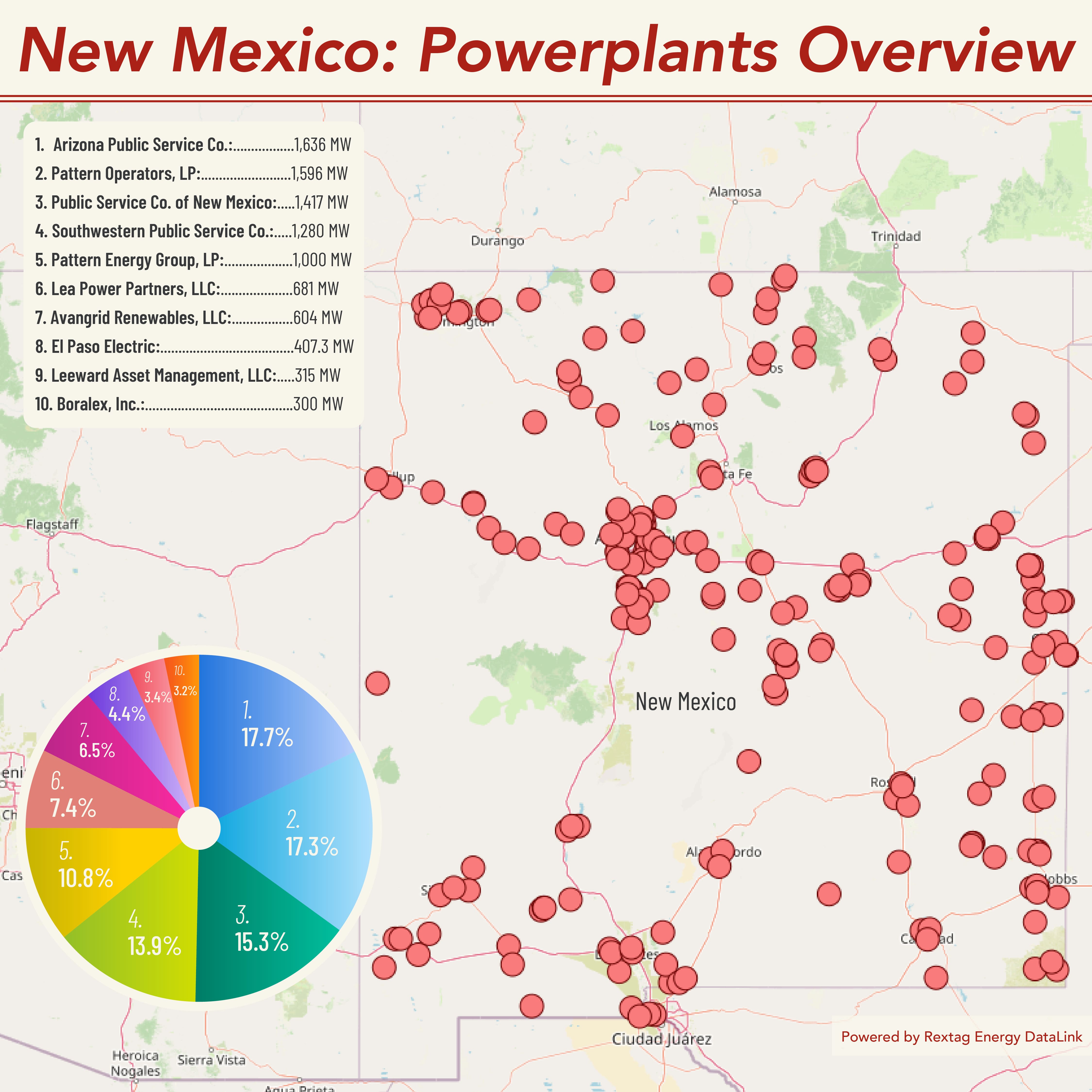
- Power Plants: 12196 MW
- Solar: 1035 MW
- Wind: 4363 MW
- Hydrogen Plants: 38 MMcf/d
- Geothermal: 1535 Geothermal Sites
- Carbon Capture Storage: Max Capacity 6 million tonnes per annum (MTPA)
Wind energy dominates New Mexico's renewable sector, contributing 84% of its renewable generation in 2022
In 2019, New Mexico took significant strides to revamp its renewable energy strategy by updating the Renewable Portfolio Standard (RPS) first established in 2004. The updated law sets ambitious targets for investor-owned utilities, requiring them to source 50% of their electricity sales from renewable resources by 2030, escalating to 80% by 2040, and achieving 100% by 2045. Rural electric cooperatives have a slightly extended timeline, with a deadline of 2050 to meet the 100% renewable requirement.
In 2022, renewable sources were responsible for about 42% of all electricity generated within New Mexico from both utility-scale and small-scale facilities. Wind energy was the powerhouse behind this achievement, accounting for 84% of the renewable energy produced and 35% of the state's total electricity generation. The state boasts the largest wind farm in eastern New Mexico, which has a capacity of 522 megawatts, underscoring its pivotal role in the state’s energy landscape.
As of early 2023, New Mexico ranked ninth in the nation in terms of wind capacity, with approximately 4,411 megawatts installed.
Wyoming
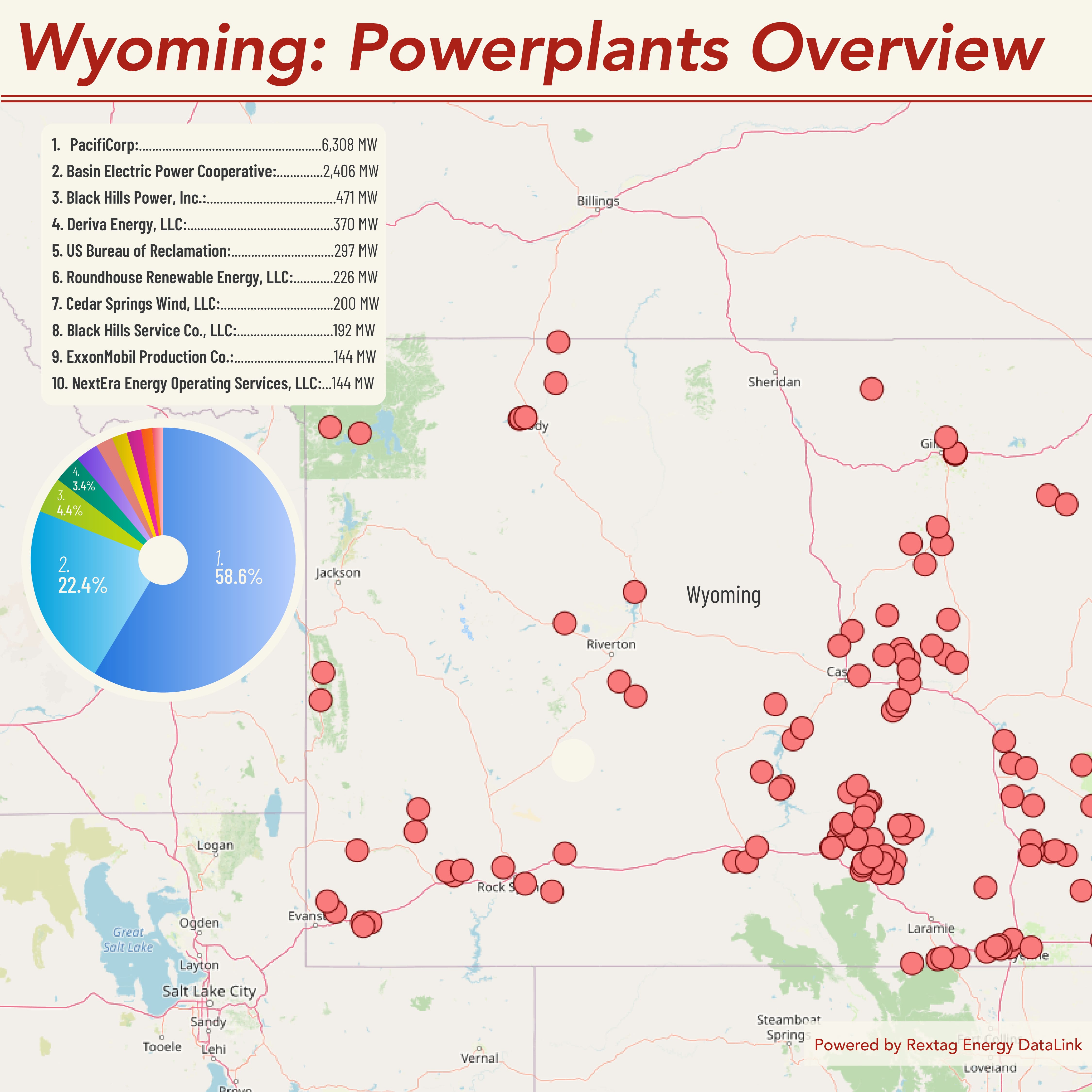
- Power Plants: 8399 MW
- Solar: 92 MW
- Wind: 3131 MW
- Hydrogen Plants: 38 MMcf/d
- Geothermal: 800 Geothermal Sites
- Carbon Capture Storage: Max Capacity 16 million tonnes per annum (MTPA)
Despite lacking a Renewable Portfolio Standard, Wyoming generated 24% of its electricity from renewables in 2022, with wind power leading the way
Wyoming stands out in the U.S. energy scene, not for having a renewable portfolio standard (RPS) or specific renewable energy goals, but for its significant contribution to renewable energy production despite this absence. In 2022, renewable sources supplied 24% of Wyoming's electricity, with wind power making up approximately 90% of this renewable output. Wyoming's geography, particularly in the southeastern part of the state, is ideal for wind energy production. The region's consistent and strong winds, funneled through mountain passes onto the high prairies, allow wind farms to operate at high efficiency.
As of early 2023, Wyoming had installed over 3,000 megawatts of wind power capacity, with plans to add another 830 megawatts by 2024. Several large-scale wind projects are either underway or in planning stages, including the massive Chokecherry-Sierra Madre project. This project is set to include around 900 turbines, contributing an additional 3,000 megawatts to the grid between 2027 and 2029.
Hydroelectric power, although less dominant, still plays a crucial role in Wyoming's energy mix. It accounted for about 2% of the state’s total electricity generation in 2022 and nearly 10% of its renewable generation. The state operates 16 hydropower dams, further diversifying its renewable energy portfolio.
Colorado
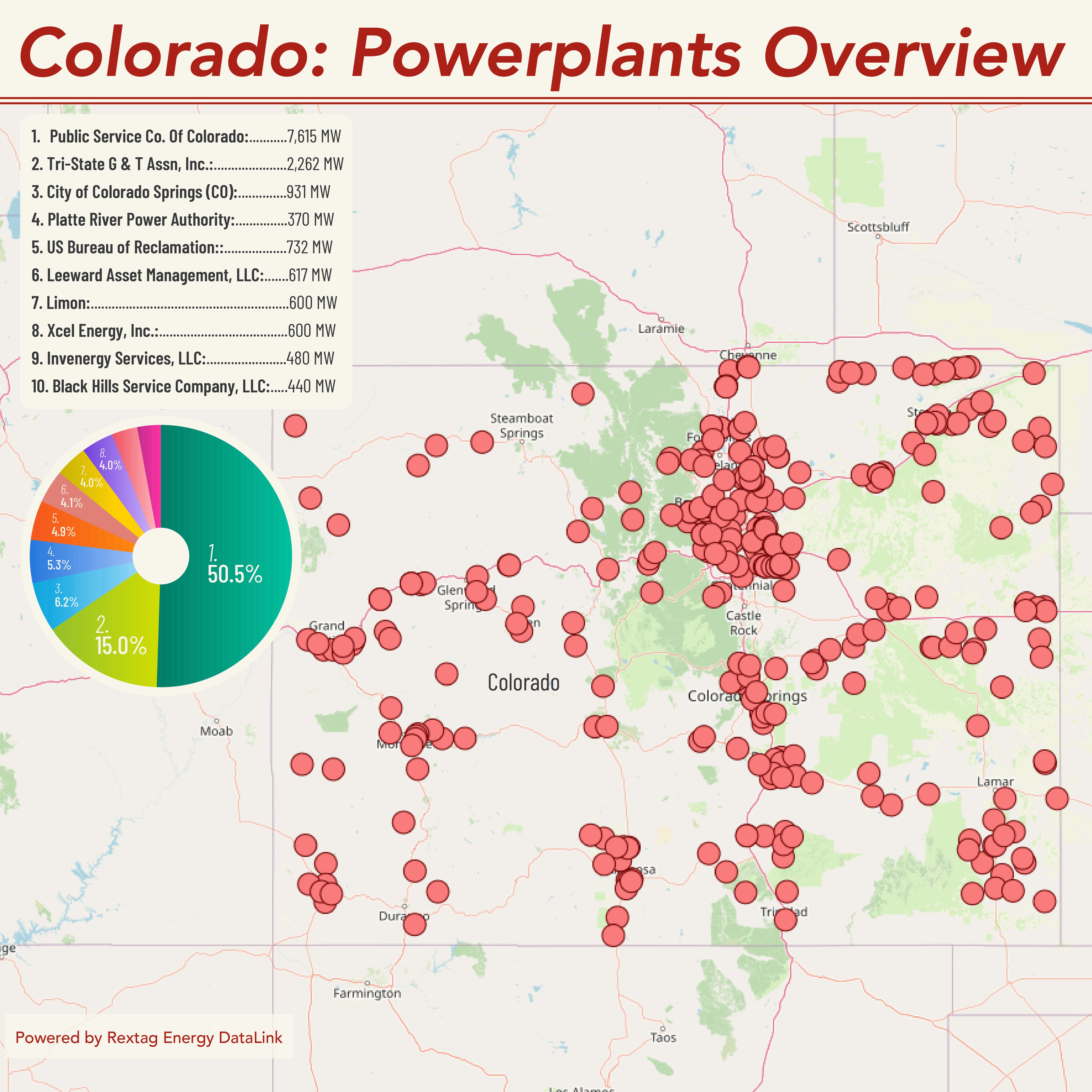
- Power Plants: 56368.82 MW
- Solar: 36214.82 MW
- Wind: 5780.1 MW
- Hydrogen Plants: 10236.45 MMcf/d
- Carbon Capture Storage: Max Capacity 2,86 million tonnes per annum (MTPA)
Colorado stands seventh nationwide in wind power capacity
In 2004, Colorado became the first state to establish a voter-approved renewable portfolio standard (RPS). This pioneering move set a goal for investor-owned utilities to source 30% of their electricity from renewable energy by 2020, with 3% from distributed, small-scale generation.
Colorado's vast wind energy resources on its eastern plains and mountain crests have propelled it to seventh in the nation for installed wind power capacity. Wind energy use in the state has quadrupled since 2010. In 2022, a new wind project added 145 megawatts, pushing Colorado's total wind capacity to 5,136 megawatts. Another 380 megawatts are expected to be operational by the end of 2024.
The state is also making significant strides in solar energy, particularly in the sunny southern regions near the New Mexico border. In 2022, Colorado ranked eleventh among states for utility-scale solar capacity, with 1,294 megawatts installed. Plans are in place to boost this capacity by an additional 1,722 megawatts by the end of 2024. Small-scale solar installations, such as rooftop solar systems, continue to grow and made up about two-fifths of the state's total solar output in 2022.
While some oil and gas companies in Colorado, particularly on the Western Slope, have started recycling this contaminated water, in the Denver-Julesberg Basin, which is the state's most significant oil field, most of the polluted water is permanently disposed of.
The backdrop to these industry practices is a broader context of shifting energy policies and growing environmental concerns in Colorado. The state ranks among the top ten in the U.S. for oil and gas production and has made substantial advances in renewable energy use, with renewables now comprising 37% of its total electricity generation as of 2022. These efforts include a variety of state and local initiatives aimed at transitioning away from fossil fuels and enhancing energy efficiency through the use of wind and solar power, battery storage, and other measures.
Utah
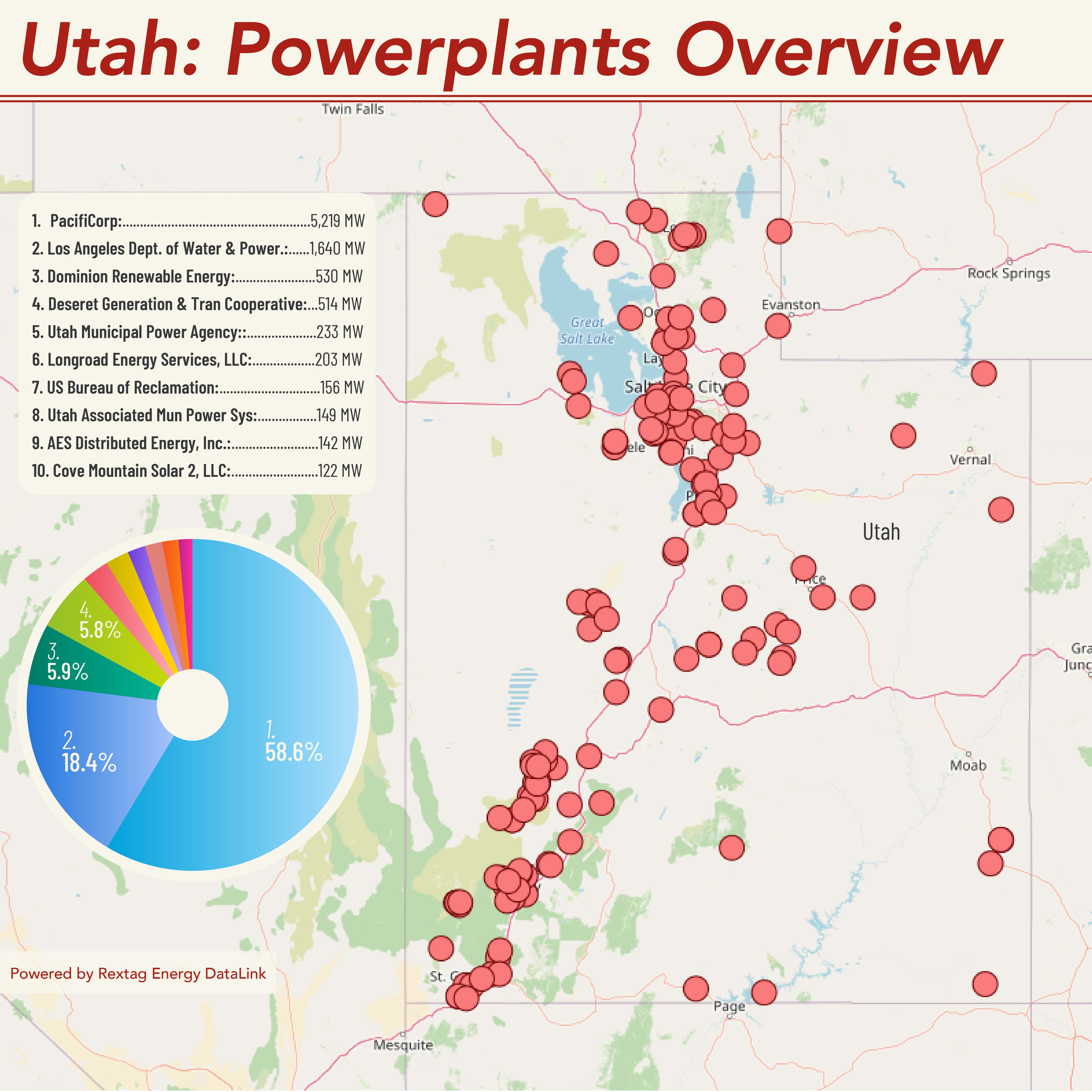
- Power Plants: 6599 MW
- Solar: 1592 MW
- Wind: 387 MW
- Hydrogen Plants: 38 MMcf/d
- Geothermal: 1973 Geothermal Sites
- Carbon Capture Storage: Max Capacity 18 million tonnes per annum (MTPA)
Solar energy now provides three-fourths of Utah's renewable power
Utah has a set goal for its electric utilities: by 2025, 20% of its electricity should come from renewable sources, but only if it's cost-effective. This strategy is already showing significant progress. In 2022, renewables accounted for 16% of Utah’s electricity, with solar energy leading the charge.
Solar power in Utah, which includes both small rooftop systems and large solar farms, made up about 75% of the renewable energy produced last year. The growth in solar power has been explosive — it was nearly 50 times greater in 2022 than in 2015. By the end of the year, Utah ranked ninth nationwide in solar capacity, with 1,537 megawatts installed.
Geothermal energy also plays a role in Utah's energy mix. The state is one of only seven in the U.S. that generates electricity from geothermal sources. In 2020, geothermal plants in southwestern Utah generated about 7% of Utah’s renewable electricity. Recognizing its potential, the state is looking to expand; in April 2022, the U.S. Interior Department made 32,500 acres available for geothermal development.
Arizona
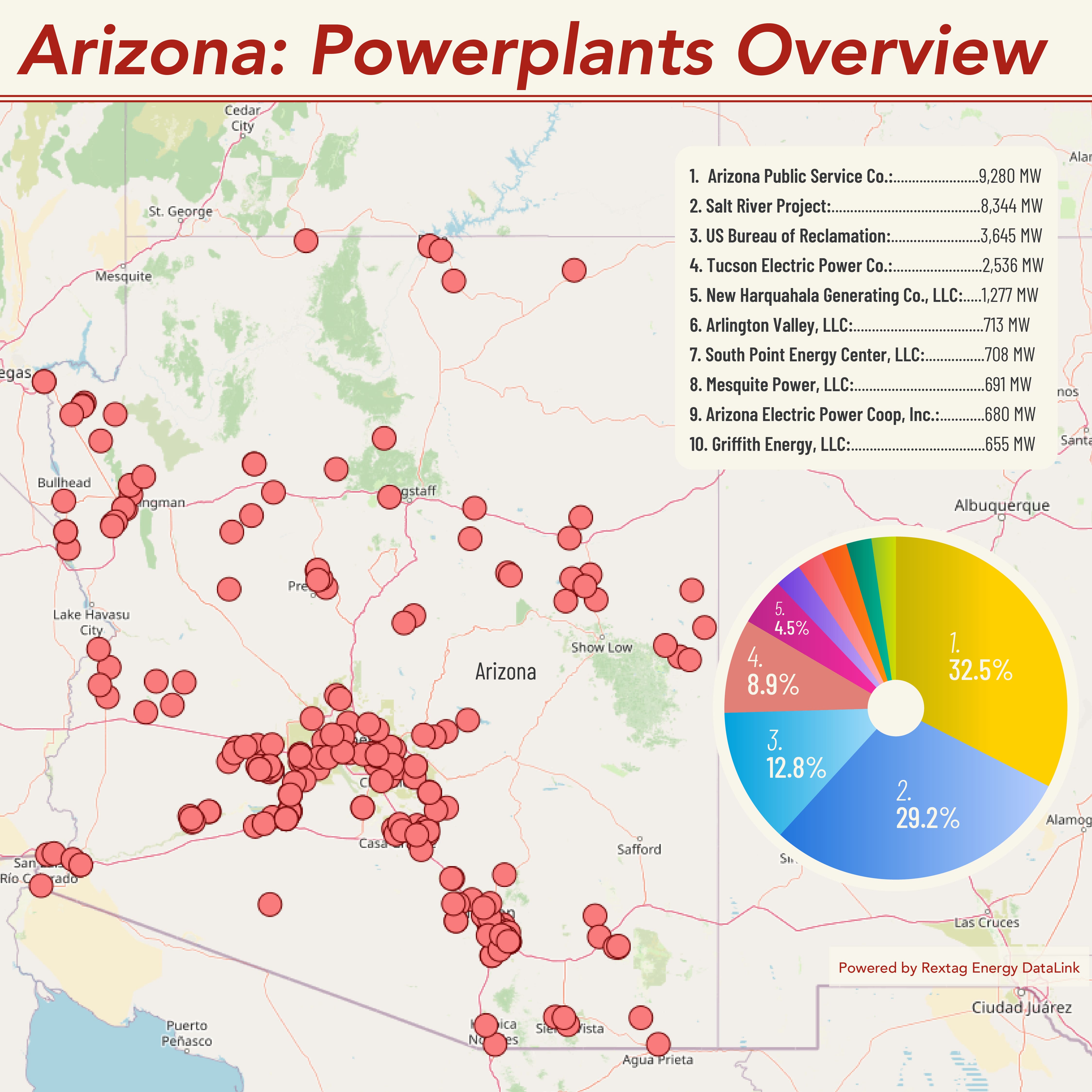
- Power Plants: 26103 MW
- Solar: 3868 MW
- Wind: 577 MW
- Hydrogen Plants: 38 MMcf/d
- Geothermal: 2024 Geothermal Sites
Arizona is a top-five state for solar electricity generation in the U.S.
Arizona with its sunny climate became a leader in solar energy. Since establishing a renewable energy standard (RES) in 2006, the state mandates that regulated electric utilities source 15% of their electricity from renewables by 2025, with 4.5% specifically from customer-based installations like rooftop solar panels.
The state's largest utility aims to supply 100% carbon-free energy by 2050, targeting 45% by 2030. This plan includes a mix of nuclear and renewable sources. Another major utility is on track to achieve over 70% of its power from wind and solar by 2035, showing a strong shift toward renewable energy.
In 2022, renewables generated 17% of Arizona's total electricity, with solar power contributing nearly 60% of that renewable energy. The rise of solar has been significant: solar installations surpassed hydroelectric power in 2017 as the primary source of renewable energy. By 2022, solar accounted for about 10% of Arizona's overall electricity generation.
Arizona ranks among the top states for solar potential and installation, with more than 5,483 megawatts of capacity from both large and small-scale solar setups. It was the fifth-leading state for solar generation in 2022, behind heavyweights like California and Texas, with large-scale facilities driving most of the production, complemented by significant contributions from residential solar panels.
Wrapping Up
In 2023, California led the nation in solar energy production, generating over 68,800 GWh, more than double that of any other state. Texas followed with 31,700 GWh, along with Florida, North Carolina, and Arizona, accounting for most of the U.S.'s 238,000 GWh of solar generation. Texas also saw significant growth, adding nearly 5,000 MW of new solar capacity, a 37% increase from 2022.
Texas was the clear leader in wind power, producing 119,836 GWh, more than the next three states combined. While Texas added 1,309 MW of new wind capacity, Arizona and New York saw the largest relative increases, at 39% and 25% respectively. Wind now generates around 10% of U.S. electricity, doubling its share since 2014.
The rapid expansion of solar and wind is crucial for the U.S. to meet its climate goals, including a 50-52% reduction in emissions by 2030 and 100% carbon-free electricity by 2035. Recent policy incentives, such as the Inflation Reduction Act, are expected to accelerate the growth of these renewables, potentially making up over 50% of electricity capacity by 2035 in most states, with some states reaching over 80%.
If you are looking for more information about energy companies, their assets, and energy deals, please, contact our sales office mapping@hartenergy.com, Tel. 619-349-4970 or SCHEDULE A DEMO to learn how Rextag can help you leverage energy data for your business.
Renewable Energy and Decarbonization: From Renewable Diesel to Electrofuel, Biofuel and Geothermal Power
![$data['article']['post_image_alt']](https://images2.rextag.com/public/blog/291_Blog_Renewable Energy and Decarbonization From Renewable Diesel to Electrofuel, Biofuel and Geothermal Power.jpg)
Renewable diesel, a cousin to traditional petroleum diesel, stands out as a standalone fuel and a blendable option. In 2022, it accounted for about 8% of all U.S. biofuel production and 9% of its consumption. For decades, diesel has been the stalwart choice for both shippers and carriers, valued for its reliability. Yet, as sustainability becomes a priority, these industries are now navigating the complex world of alternative fuels. This shift has its challenges; the array of choices comes with varying information about availability, cost, performance, and environmental impact. Amidst these options, renewable diesel is gaining traction.
Can Oil-Rich Texas Be a Clean Energy Titan: Sugary Sweet Attempt at Leading the Renewable Revolution
![$data['article']['post_image_alt']](https://images2.rextag.com/public/blog/315_blog_Can Oil-Rich Texas Be a Clean Energy Titan Sugary Sweet Attempt at Leading the Renewable Revolution.jpg)
Texas is taking bold steps toward a future powered by clean energy. Once known mainly for its oil and gas, the state is now a leader in wind, solar, and battery storage. But as electricity demand grows, so do the challenges of balancing energy needs with infrastructure limits. Here’s a look at how Texas is transforming and what hurdles lie ahead + find out who works with Facebook’s parent company Meta on new technology across the U.S.
![$data['article']['post_image_alt']](https://images2.rextag.com/public/blog/328_Blog_Why Are Oil Giants Backing Away from Green Energy Exxon Mobil, BP, Shell and more .jpg)
As world leaders gather at the COP29 climate summit, a surprising trend is emerging: some of the biggest oil companies are scaling back their renewable energy efforts. Why? The answer is simple—profits. Fossil fuels deliver higher returns than renewables, reshaping priorities across the energy industry.
![$data['article']['post_image_alt']](https://images2.rextag.com/public/blog/327_Blog_Oil Market Outlook A Year of Growth but Slower Than Before.jpg)
The global oil market is full of potential but also fraught with challenges. Demand and production are climbing to impressive levels, yet prices remain surprisingly low. What’s driving these mixed signals, and what role does the U.S. play?
![$data['article']['post_image_alt']](https://images2.rextag.com/public/blog/326_Blog_USA Estimated Annual Rail CO2 Emissions 2035.jpg)
Shell overturned a landmark court order demanding it cut emissions by nearly half. Is this a victory for Big Oil or just a delay in the climate accountability movement?